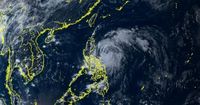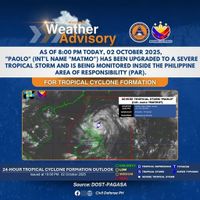On the morning of October 3, 2025, the Philippines faced the full force of Typhoon Paolo—also internationally known as Matmo—just days after a devastating earthquake rocked the central region of the country. According to the Joint Typhoon Warning Center, Matmo had strengthened to typhoon status in the Philippine Sea, with satellite imagery revealing a well-formed, symmetrical eye, signaling that the storm was not encountering anything to weaken it. This ominous sign was confirmed by the Cooperative Institute for Research in the Atmosphere (CIRA), which released footage on October 2 showing the storm slowly intensifying as it neared the northern Philippines.
The Philippine Atmospheric, Geophysical, and Astronomical Services Administration (PAGASA) issued its 8 a.m. bulletin on October 3, estimating the center of Paolo over the coastal waters of Dilasag, Aurora at 16.3°N, 122.7°E. By 9 a.m., Paolo made landfall over Dinapigue, Isabela, packing maximum sustained winds of 110 kph (68 mph) near its center and gusts reaching up to 115 kph (71 mph). The storm was moving west-northwest at 25 kph, according to PAGASA’s 11 a.m. update. In response, Storm Signal No. 4—the highest wind warning—was raised over several areas in Luzon, with Wind Signal No. 3 in effect for other northern provinces.
The impact was immediate and widespread. Several flights were canceled as early as 7:30 a.m. Friday, the Civil Aviation Authority of the Philippines reported, with airports scrambling to adjust schedules and ensure passenger safety. PAGASA warned the public to brace for hazards including floods, landslides, and storm surges, especially in Northern and Central Luzon. Paolo, the 16th tropical cyclone to hit the Philippines in 2025, was bringing moderate to torrential rain and fierce winds, while its trough or extension caused scattered rain and thunderstorms across the rest of Luzon and Western Visayas.
For many Filipinos, Paolo’s arrival was especially harrowing given the country’s recent trauma. On the night of September 30, a powerful 6.9-magnitude earthquake struck the central Philippines, its epicenter located roughly 12 miles northeast of Bogo City in Cebu Province. The tremor, which occurred at a shallow depth of just three miles, caused the collapse of homes, bridges, and public buildings across northern Cebu. According to The Associated Press, landslides and widespread power outages followed in the earthquake’s wake, and by October 2, authorities confirmed 72 people dead and up to 200 injured. The Philippine National Police announced that all missing persons had been accounted for, but more than 20,000 people were displaced, with thousands sleeping in open spaces out of fear of aftershocks.
One of the highest death tolls was reported in Bogo City, where about half the fatalities occurred. In San Remigio, tragedy struck when a portion of its sports complex collapsed during a basketball game, killing at least five people, including a child and members of the coast guard and fire department. The Philippine Institute of Volcanology and Seismology (PHIVOLCS) briefly issued a tsunami warning after the quake, but it was withdrawn within hours as no waves materialized. At least 22 buildings sustained major damage, including schools, a commercial structure in Bantayan, and a heritage church. Classes were suspended in 46 municipalities, and blackouts were reported in parts of Cebu, Leyte, and Biliran due to grid disruptions. Three bridges, including the Mandaue–Mactan Bridge, remained impassable, and six municipalities experienced Intensity VII shaking—classified as destructive.
As rescue teams searched through piles of broken concrete, twisted metal, and splintered wood using backhoes, sniffer dogs, and even their bare hands, aftershocks continued to rattle the region. Data Friendly Space, a U.S.-based NGO, reported more than 2,400 aftershocks by October 2. In one Bogo neighborhood, officials reported 10 deaths in a cluster of houses originally built for survivors of a 2013 super typhoon, underscoring the country’s vulnerability to recurring natural disasters.
Complicating matters further, the earthquake was followed by a minor phreatomagmatic eruption at the Taal Volcano in Batangas at 2:02 a.m. on October 1—about four hours after the quake. PHIVOLCS clarified that the eruption was unrelated to the earthquake and did not pose a broader threat. Nonetheless, the back-to-back disasters left many Filipinos on edge.
As Typhoon Paolo (Matmo) approached, authorities warned that its impact could intensify as it neared densely populated regions, many of which were still reeling from both the earthquake and a prior tropical storm that struck central Philippines on September 26, killing at least 27 people and prompting mass evacuations. The Hong Kong Observatory had forecasted that Matmo would cross over the Philippines on October 3 before strengthening into a typhoon that evening. While it was not expected to become a major super typhoon, it was forecasted to begin dissipating early Sunday, October 5, after making landfall near the China-Vietnam border, according to Reuters.
Typhoon season in the region is a year-round phenomenon, with most storms forming from early July through mid-December. The Philippines, along with Japan, Taiwan, the Korean Peninsula, China, and Vietnam, is frequently battered by typhoons, which bring damaging winds and storm surges. The memory of Super Typhoon Mawar, which caused billions of dollars in damage to Guam in May 2023, still lingers for many in the region.
As of Friday morning, Paolo’s extension continued to bring scattered rain and thunderstorms to the rest of Luzon and Western Visayas, with PAGASA maintaining its warnings for floods, landslides, and storm surges. Officials emphasized the importance of vigilance, urging residents in affected areas to heed evacuation orders and monitor updates as the situation evolved.
While Matmo was not expected to develop into a major super typhoon, the storm’s heavy rains and strong winds posed a serious threat to communities already pushed to the brink by recent disasters. The international name Matmo, derived from the Chamorro language of Guam and meaning “heavy rain,” was proving all too apt as the typhoon’s bands swept across the archipelago.
With the Philippine government and local authorities working around the clock to coordinate relief efforts and ensure the safety of residents, the resilience of the Filipino people was once again put to the test. As the weekend approached, the nation braced for further challenges, hoping that the worst would soon pass and recovery could begin in earnest.






